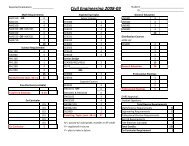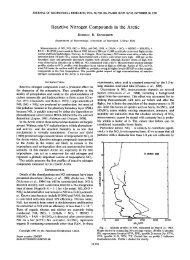Evaluation of Septic Tank and Subsurface Wetland for
Evaluation of Septic Tank and Subsurface Wetland for
Evaluation of Septic Tank and Subsurface Wetland for
Create successful ePaper yourself
Turn your PDF publications into a flip-book with our unique Google optimized e-Paper software.
ased upon a higher hydraulic loading estimate than what is actually received. The<br />
frugality <strong>of</strong> water use inspired by sole dependence on rainwater resulted in extremely low<br />
water use per capita, so the oversized wetl<strong>and</strong> has never produced effluent <strong>and</strong> thus<br />
functions as an evapotranspiration bed.<br />
Figure 3-5 Pisgah wetl<strong>and</strong> at the beginning <strong>of</strong> the evaluation with ten month old<br />
wild cane. The design engineer is st<strong>and</strong>ing at the mid-wetl<strong>and</strong> sample point used <strong>for</strong><br />
collecting the “effluent” sample. (Photograph by author.)<br />
The plants at the inlet end <strong>of</strong> the wetl<strong>and</strong> (left side <strong>of</strong> Figure 3-5) were significantly<br />
higher <strong>and</strong> greener than the cane at the outlet end. The cause <strong>for</strong> the abrupt difference in<br />
plant height was not determined. The entire bed had good sun exposure. The tall cane<br />
grew to approximately 12 feet (3.7 m) with some shoots up to 15 feet (4.6 m) high. After<br />
Hurricane Ivan struck in September 2004, this cane was bowed over from the wind so it<br />
was cut to a height <strong>of</strong> 10 - 30 inches (25 – 76 cm). One sucker shoot, measured three<br />
19








